Architecture
Architecture is concerned with the design and construction of buildings. The architecture of a place is often a tourist attraction in its own right. Many buildings are quite beautiful to look at and the view from a tall building or from a cleverly-positioned window can be a beauty to behold. Architecture overlaps considerably with other fields including urban planning, civil engineering, decorative arts, interior design and landscape design.

Some of the finest examples of architecture are almost fractally interesting — there is something worth a look whatever scale you choose. From a meter away, the impressive thing about the Taj Mahal is the fine stone inlay work on many surfaces. Moving back, one sees the building as a whole and the extensive gardens; to get the full context one needs to look at the history of the Mughal Empire and the traditions of Islamic art. Someone looking at a Frank Lloyd Wright house might consider anything from what it would be like to cook in that kitchen to how the place fits into its neighbourhood.
Many examples of fine architecture are on the UNESCO World Heritage List.
Understand
Historic buildings often tell their own story and provide a place with a heritage that asks the visitor to find out more. While architecture used to be limited by the styles and tastes of the area it was built in and even more the locally available material, the widespread adoption of concrete, glass and steel as well as an international exchange of architectural ideas have led to a new "global" style that is loved and hated in almost equal measure.
Ancient buildings
- Stonehenge
- Pyramids in many places, most notably the great Egyptian pyramids at Giza
- The Egyptian temples of Karnak, Luxor (in the eponymous city) and Abu Simbel
- The Parthenon in Athens
- The Great Wall of China
- Remnants of the Roman Empire throughout Europe, Western Asia and North Africa. Architectural feats of the Roman Empire remain impressive for their longevity if nothing else. Many feats of civil engineering were only reached again in the industrial revolution surpassed in the 19th century or even later. The Romans used concrete and built bridges and dug tunnels that stood the test of time. Later generations even mistook those accomplishments for superhuman feats as names like "Devil's Wall" for the Limes attest. Some of the most notable sites are:
- The Pantheon in Rome - best preserved Roman temple anywhere, oldest important building in the world with its original roof intact - a dome with a revolutionary design for its time (which remains the record holder for the biggest unreinforced concrete dome in the world), probably designed by emperor Hadrian; widely claimed as THE ultimate architectural masterpiece of all time.
- The Pont Du Gard aqueduct near Nîmes
- Theaters at Orange and Taormina
- Amphitheaters at Verona, Pula and El Jem
Religious buildings
- See also: Religion and spirituality
Cathedrals, temples and other places of worship have, until modern times, been among the most notable and longest lasting forms of architecture, usually dominating their city or village.
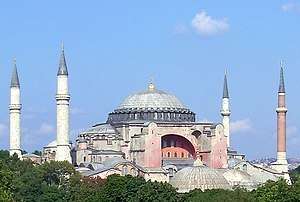
Some buildings have been centers of worship for two or more religions.
- Hagia Sophia was built in as an Eastern Orthodox cathedral in Constantinople in 537 CE, during the late stages of the Roman Empire, and it served as an Orthodox church for centuries. Crusaders turned it into a Roman Catholic church, but that lasted only 1204-1261. When the Ottoman Empire took over in the 1450s, the city became Istanbul and the building became a mosque. Since Kemal Ataturk's mostly secular revolution in the 1920s it has been a museum.
Cathedrals
- See also Christianity, Gothic architecture, Longobard sites, Wooden tserkvas of the Carpathian region
Perhaps the most well known architectural styles for churches are "Gothic" and the subsequent Renaissance style. Many Gothic cathedrals took generations or even centuries to build. The Cologne Cathedral for instance was started in the Middle Ages and not finished until the 19th century and today work to conserve and restore dilapidated parts is again ongoing. Prior to the Gothic style the Romanesque style was prevalent in much of Europe. This style is distinguished by its thick walls and heavy round arches that sharply contrast with the more filigrane pointy arches of the Gothic style. While "Gothic" was invented as a slur by opponents of the style, a revival occurred in the nineteenth century and even many US cities now have Gothic houses of worship.
In areas where stone of an appropriate quality was hard or impossible to come by a unique "Brick Gothic" style developed that is especially prevalent in Northern Germany and other areas of the former Hanseatic League. One of the most notable ensembles of buildings of that style is found in Lübeck.
- Basilique de Saint-Denis north of Paris
- Cathedrals of Reims and Chartres
Many areas that were colonized by European powers, especially the Catholic powers, also have fine cathedrals. One of Macau's best-known sights is the ruins of a cathedral, the Philippines has several, and there are examples all over Latin America.
Mosques
- See also Islam
- Masjid al-Haram in Mecca, the place all Muslims face toward during prayer and the main destination for the Hajj pilgrimage
- Dome of the Rock/Masjid Al Sakhrah in Jerusalem
- The ancient Silk Road ran through mainly Muslim territory and there are fine mosques all along it.
- The many mosques built in the Indian subcontinent under the Mughal Empire
Temples
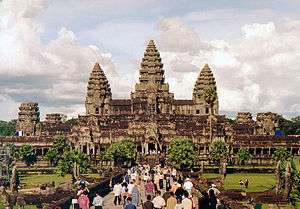
- Angkor Wat, originally a temple of the Hindu god Vishnu
- The many pagan temples of Ancient Greece and the Roman Empire
- Manichaeism started around 250 CE in Persia and at its peak around 500 was quite widespread, but it was gone by around 1400. The only surviving temple is in jinjiang, a suburb of Quanzhou. Quanzhou was formerly one of the great Silk Road ports and has many other religious structures.
Stupas
Civic buildings
.jpg)
There are a large number of buildings for civic or governmental purposes. These include:
- Seats of government in the case of (former) "merchant Republics" like the members of the Hanseatic League even (former) seats of municipal government can be impressive as they were designed to show off wealth
- Buildings for the legal system, including courthouses and prisons; see history of justice
- In general anything representing a country or city can be designed to make an architectural statement; sometimes a (building near a) border crossing will be more opulent and impressive than strictly necessary for its utilitarian purposes; court buildings will often be adorned with statues of Iustitia, the Roman goddess/representation of justice and may be intended as "palaces of justice"
Industrial buildings
- See also: Industrial tourism
While specialized manufacturing has been going on since the dawn of mankind, it was the Industrial Revolution from the 18th century that made industrial buildings dominate their surroundings.
While industrial buildings tend to be shaped by their function, some of them are marvels of architecture.
Transport infrastructure
Railway stations of the 19th century have been likened to cathedrals and some historians argue that the rising bourgeoisie built them as architectural statements for the ages similar to how medieval cities built cathedrals. There is a dearth of architecturally remarkable stations during the 20th century, but the 21st century has seen a number of impressive representative buildings for new or improved transportation services.
- Transportation centers such as railway stations and airports; in some cases even something as seemingly commonplace as a public transport station has been designed as an architectural statement. See also travel for rail enthusiasts and urban rail adventures.
- Urban rail systems often have stations designed in various eras according to the style then en vogue. The Paris Metro is particularly noteworthy for its station design, but the Berlin U-Bahn with "house architect" Alfred Grenander (who was actually Swedish and died in 1931) has a few impressive stations as well and after a period of budget dictating design choices is again taking aesthetic considerations into account for the new stations of U5. Washington DC Metro is widely considered the most beautiful example of Brutalism and even people who otherwise despise that style acknowledge its aesthetic value there. Moscow, London, and Stockholm also have stations with significant architectural merit both above and below ground.
Memorials
Around the world, commemorative structures are amongst the most notable tourist attractions. For example:
- Tombs
- The burial mounds of some prehistoric groups; see archaeology
- Egyptian pyramids
- Chinese tombs, including the first Qin Emperor's tomb with the Terracotta Warriors
- The Taj Mahal in Agra, tomb of an Emperor's wife
- Many capital cities around the world have a War Memorial or a Tomb of the Unknown Soldier
Record-holding structures
Building the tallest building in the world is every architect's dream (or perhaps nightmare) project, as it will eventually be topped by an even taller structure. See the Chicago skyline guide for information on the many tall buildings in Chicago, the birthplace of the skyscraper.
Tallest buildings
The following buildings, all over 350 meters, were each at one time the tallest building in the world.
- Burj Khalifa, Downtown Dubai, Dubai, UAE (built 2010) 160 storeys 828 m
- Taipei 101, Xinyi District, Taipei, Taiwan (built 2004) 101 storeys 509 m
- Petronas Towers, Golden Triangle, Kuala Lumpur, Malaysia (built 1998) 88 storeys 452 m
- Sears Tower, the Loop, Chicago, USA (built 1974) 110 storeys 442 m
- Empire State Building, Midtown, Manhattan, New York, USA (built 1931) 102 storeys 381m
This is the current (as of 2018) list of the ten tallest buildings in the world. The rankings depend on how exactly you define "tallest" and "building", so different sources give slightly different lists, but everyone agrees that the Burj Khalifa is the tallest by far.
- Burj Khalifa, Downtown Dubai, Dubai, UAE (built 2010) 160 storeys 828 m
- Shanghai Tower, Pudong, Shanghai, China (built 2015) 128 storeys 632 m
- Abraj Al Bait Clock Tower, Mecca, Saudi Arabia (built 2012) 120 storeys 601 m
- Ping An Finance Centre, Shenzhen, China (built 2017) 118 storeys 599 m
- Lotte World Tower, Songpa, Seoul, South Korea (built 2016) 123 storeys 554.5 m
- One World Trade Center, Financial District, Manhattan, New York City, United States (built 2014) 104 storeys 541.3 m
- (tied) Guangzhou CTF Finance Centre, Tianhe District, Guangzhou, China (built 2016) 111 storeys 530 m
- (tied) Tianjin CTF Finance Centre, Tianjin, China (under construction) 98 storeys 530 m
- China Zun, Chaoyang District, Beijing, China (under construction) 108 storeys 528 m
- Taipei 101, Xinyi District, Taipei, Taiwan (built 2004) 101 storeys 509 m
The number eight is considered lucky in much of East Asia and hence this number is often deliberately chosen for things like number of floors.
Tallest towers

These towers, all over 300 meters, were each at one time the tallest tower in the world.
- Tokyo Skytree, Sumida, Tokyo, Japan (built 2012) 634 m
- Canton Tower, Haizhu, Guangzhou, China (built 2010) 604 m
- CN Tower, Downtown Toronto, Canada (built 1976) 553 m
- Ostankino Tower, outskirts of Moscow, Russia (built 1967) 540 m
- Tokyo Tower, Minato, Tokyo, Japan (built 1958) 333 meters
- Eiffel Tower, 7th arrondissement, Paris, France (built 1889) 300 m when built, 324 m with TV antenna.
This is the current (2018) list of the ten tallest towers in the world.
- Tokyo Skytree, Sumida, Tokyo, Japan (built 2012) 634 m
- Canton Tower, Haizhu, Guangzhou, China (built 2010) 604 m
- CN Tower, Downtown Toronto, Canada (built 1976) 553 m
- Ostankino Tower, outskirts of Moscow, Russia (built 1967) 540 m
- Oriental Pearl Tower, Pudong, Shanghai, China (built 1995) 468 m
- Milad Tower, Tehran, Iran (built 2007) 435 m
- KL Tower, Golden Triangle, Kuala Lumpur, Malaysia (built 1994) 421 m
- Tianjin Radio and Television Tower, Tianjin, China (built 1991) 415 m
- Central Radio and TV Tower, Haidian District, Beijing, China (built 1992) 405 m
- Zhongyuan Tower, Zhengzhou, China (built 2011) 388 m
Sky Tower in Auckland, New Zealand (built 1997) at 328 m is the tallest in the Southern Hemisphere.
In the USA and Poland there are some guyed radio masts that are taller than some of the items on this list. After the Burj Khalifa, the tallest construction built so far is the Warsaw radio mast near Gabin.
Other records
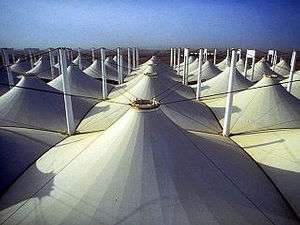
Of course, height is not the only way in which a building might be remarkable. Other records include:
- The Marina area of Dubai had seven of the world's ten tallest residential buildings as of 2010.
- Edificio Copan in São Paulo is "only" 38 stories, but it has 1160 apartments and is considered the world's largest residential building by floor area
- Largest buildings by roof area: the two Hajj terminals at Jeddah airport, which each handle dozens of large aircraft carrying Muslim pilgrims.
- Longest structure on Earth: the Great Wall of China is several thousand km. It is arguably not really all one structure, different parts having been built by different dynasties centuries apart, but even those parts are enormous.
- Depending on how you define "structure" the great Dingo-fence that crosses Australia is even larger than the great wall of China
Several industrial buildings are huge due to the nature of the work done there. Examples include:
- The former Cargolifter hall in Brandenburg, which has the biggest single span roof in the world and was designed to hold a Zeppelin that never was and now houses a tropical themed water amusement park
- The Meyer Werft in Papenburg, Lower Saxony where cruise ships are built (tour possible). It is by far the biggest dry dock and one of the biggest buildings in the world.
- The Boeing factory in Everett (Washington), Washington state - the biggest man made structure by interior volume
Unusual buildings
Some buildings are unique....
- The Leaning Tower of Pisa is often considered unusual, though a pagoda in Suzhou has been called the "leaning tower of China" and there are other less famous leaning towers in various countries, including several elsewhere in Italy.
- Prora on the Baltic Sea has a hotel for 20,000 workers on holiday, created by the Nazi regime in Germany, never used for its intended purpose, never completed, later used as barracks by the GDR, and now housing a museum as well as accommodation while being mostly empty
- The Hakka Tulou of southern China are mostly-earth easily-defended buildings, home to entire clans of a few hundred people
- The diaolou (castles) of Kaiping are fanciful houses built by overseas Chinese, mostly in the early 20th century
Architectural styles
Some styles like Art Deco attract tourists to visit. The town of Napier, New Zealand, is largely built in the Art Deco style after the town was rebuilt in the 1930s following an earthquake. The local historical society has capitalised on this and runs frequent walking tours around the buildings.
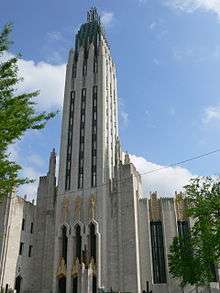
See also:
- Islamic architecture
- Gothic architecture
- Renaissance architecture
- Mughal architecture
- Art Deco architecture
With the rise of the automobile, novelty architecture has been used as a means of roadside promotion. Examples would include restaurants shaped like oversized oranges or motels in which each room is a railway caboose or a concrete wigwam.
In Latin America, Spanish architecture (which itself was considerably influenced by Arab styles during the Muslim rule over parts of Iberia) was adapted to local conditions and combined with native ideas to create the "colonial" style still evident in cities like Granada (Nicaragua) or León (Nicaragua).
Well-known architects
Le Corbusier

The Swiss-French architect Charles-Édouard Jeanneret-Gris (1887-1965) was better known under his artist name, Le Corbusier. Regarded as one of the fathers of modern architecture and urban planning, his buildings can today be seen in Europe, the Americas and Asia. His architecture and his views regarding how people should use his buildings remain controversial to this day and if you see his creations, you might get an idea why.
Some works of this architect are the planned city of Chandigarh, the Villa Savoye in Poissy outside Paris where he expressed his "five points of new architecture", the Immeuble Clarté in Geneva, the Centrosoyuz Building in Moscow, the Carpenter Center for the Visual Arts in Cambridge (Massachusetts), four "Unité d'habitation" apartment buildings around Europe which later served as inspiration for Brutalist architecture and many "villas" in France and Switzerland including his own cabin on the French Riviera where he spent the last years of his life.
In 2016, 17 of his creations were listed by UNESCO as a world heritage site named "The Architectural Work of Le Corbusier, an Outstanding Contribution to the Modern Movement".
I.M. Pei

I.M. Pei (1917-) spent his early years in China, but came to the USA for university and has lived there most of his life. He has designed buildings in many places. He is very much a modern architect, heavily influenced by the European Bahaus school. Pei designed a number of important public buildings including Dallas city hall, the National Center for Atmospheric Research in Boulder, and the Kennedy Library and the John Hancock Tower in Boston. He has also done commercial buildings, notably the Bank of China tower in Hong Kong.
Museums were a specialty; perhaps his best-known work is the controversial glass pyramid outside the Louvre in Paris. Other projects included the East Building of the National Gallery of Art in Washington, DC, an extension of the German Historical Museum in Berlin. the Rock and Roll Hall of Fame in Cleveland, the Museum of Islamic Art in Doha and the Miho Museum near Kyoto. He came out of retirement in his 80s to design a museum for the Chinese city of Suzhou where his family were from.
Frank Gehry

The Canadian-American architect Frank Gehry (1929-) is known for his Deconstructivist creations which include Guggenheim Museum in Bilbao, Dancing House in Prague, the Art Gallery of Ontario in Toronto, MIT Ray and Maria Stata Center in Cambridge (Massachusetts), Walt Disney Concert Hall in downtown Los Angeles, the Vontz Center for Molecular Studies on the University of Cincinnati campus, New World Center in Miami Beach, Weisman Art Museum in Minneapolis, and the California Science Center in Los Angeles.
Oscar Niemeyer
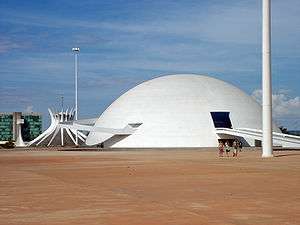
Brazilian architect Oscar Ribeiro de Almeida Niemeyer Soares Filho (1907 – 2012) is considered one of the key figures in the development of modern architecture. Strongly influenced by Le Corbusier, Niemeyer is best known for his design of civic buildings for Brasília, Brazil's planned capital city from 1960 on, and of Belo Horizonte's Pampulha Architectural Complex, a world heritage site, named as such by UNESCO on 2016. His collaboration with other architects on the United Nations Headquarters in New York City is widely praised as well. His exploration of the aesthetic possibilities of reinforced concrete was highly influential in the late 20th and early 21st centuries. Both lauded and criticized for being a "sculptor of monuments", Niemeyer is held as a great artist, and one of the greatest architects of his generation, by his supporters, and accused of a highly criticizable architecture, functionally and budget-wise, by his detractors.
Santiago Calatrava
Valencian architect, structural engineer, sculptor and painter Santiago Calatrava Valls (born 28 July 1951), early in his career, was largely dedicated to designing bridges and railway stations with a "neofuturistic" approach. He is most famous for the Olympic Communications Tower on the Montjuïc hill, built for the 1992 Olympiad, and several avant-garde bridges: the Chords Bridge in Jerusalem, the Alamillo Bridge in Seville, the Ponte della Costituzione (more popularly the Calatrava bridge) over Venice's Grand Canal, the Kronprinzenbrücke over the Spree river in Berlin, the Campo Volantin Footbridge over Nervion river in Bilbao and several others.
Mimar Sinan
"Sinan the Architect" (c. 1489/1490 – July 17, 1588), the famous Ottoman master, was born the son of a stonemason, received a technical education and became a military engineer. He rose rapidly through the ranks, became first an officer and after that a Janissary commander. In his military career, he refined his architectural and engineering skills, becoming expert at constructing fortifications of all kinds, as well as military infrastructure projects, such as roads, bridges and aqueducts. At about the age of fifty, he was appointed as chief royal architect, applying the technical skills he had acquired in the army to the "creation of fine religious buildings" and civic structures of all kinds, remaining in this post for almost fifty years. Sinan is said to have constructed or supervised 476 buildings (196 of which still survive), according to the official list of his works, the most famous and masterly built of which are, first and foremost the Selimye mosque in Edirne, followed by the Imperial mosques and bathhouses in Istanbul, Damascus and Sofia. He lies in a tomb of his own design, in the cemetery just outside the walls of the Süleymaniye Mosque, across a street named Mimar Sinan Caddesi, in his honour.
Meinhard von Gerkhan
(Born 1935 in Riga) probably one of the best known contemporary German architects, his designs include the Berlin Tegel airport the Tempodrom in Berlin, expansions to the Stuttgart and Hamburg airports as well as the new Berlin main station. However, von Gerkhan has sued Deutsche Bahn over differences between the way the main station looks now and his original design. Similarly, Tegel could probably be both more impressive and more efficient had Gerkan's original double hexagon design been built instead of the single hexagon and numerous uninspired additions that now characterize the airport.